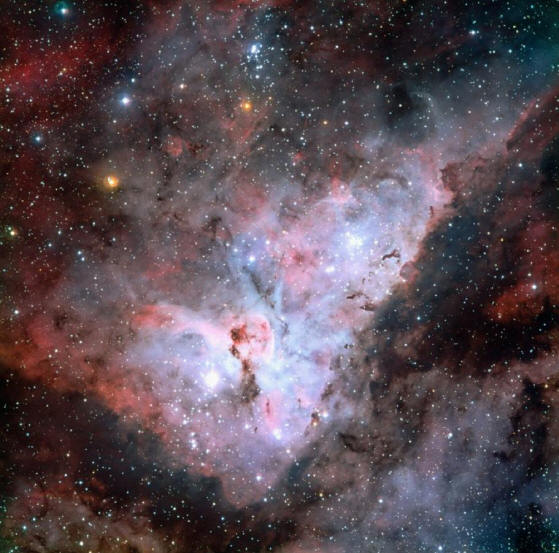|
|
Carina Breakdown
Feb 18, 2009
The Carina Nebula can’t be seen.
Natural eyesight, unaided by
technological enhancements such as
telescopes, doesn’t respond to the
meager glow.
Telescopes narrow our natural
vision, magnify the glow, and
respond to “extrasensory”
wavelengths. We shape the
instrumental responses into
simulacra of natural responses and
make sense of them in relation to
prior experiences, presumptions, and
theories.
Most astronomers presently make
sense of the
Carina Nebula according to
gravity and meteorology: They see a
cosmic perfect storm. It is a region
of short-lived giant stars, stellar
explosions, fast winds, shock waves,
and mechanically twisted lines of
frozen magnetic force. The friction
of the gravitationally driven
turbulence generates radiation from
radio waves to x-rays.
Electric Universe proponents make
sense of it through plasma
phenomena: They see a catastrophic
short-circuit in the galactic power
grid. Entangled Birkeland currents
interrupt the interstellar power
flows, and the inductive energy of
the “transmission lines” flows into
the break. The filaments of current
jump into glow mode and provide a
backlight of aurora-like curtains.
Foreground filaments still in dark
mode reveal their spiral and braided
structures (for example, the dark
DNA-like structure to the right
of Eta Carinae, the brightest star
in the lower left).
Magnetic fields generated by these
currents pull in and concentrate
surrounding plasma, pinching bits
into new stars—the cosmic
counterpart of ball lightning.
Clusters and lines of stars appear
throughout the nebula.
Primary currents induce hierarchies
of subsidiary “leakage” sparks,
filling light-year size regions with
parallel filaments of “coronal
hair.” (Examples are in the dark
nebulosity at bottom center and in
the glowing fans at upper left
center between the two yellow
stars.) Tubular
discharges—interstellar electrical
tornadoes—twist through the chaos
(at upper left, for example).
Instabilities evolve through
petroglyph-like forms, such as the
seven-rung “ladder” in the dark
filament to the right of Eta Carinae.
The sudden burst of energy along
these currents feeds supernova-size
exploding double layers (the
bubble-like forms scattered around
the region). These and other double
layers accelerate electrons and ions
to relativistic velocities. The
electrons spiral in the magnetic
fields and emit high-energy
synchrotron radiation. Slower
electrons emit radio waves. The
high-energy ions escape as cosmic
rays.
The making of sense leads to new
responses, which eventually require
new sense to be made. Therefore,
science is ever provisional. Any
proper scientific understanding of
the Carina Nebula will keep in mind
the question: How much of it still
can’t be seen?
By Mel Acheson
|
|
|
|
|
|
SPECIAL NOTE - **New Volumes Available:
We are pleased to announce a new
e-book series
THE UNIVERSE ELECTRIC. Available now, the first volume
of this series, titled Big Bang, summarizes the failure of modern cosmology
and offers a new electrical perspective on the cosmos. At
over 200 pages, and
designed for broadest public appeal, it combines spectacular
full-color graphics with lean and readily understandable
text.
**Then second and third volumes in the series are now available,
respectively titled Sun and Comet, they offer
the reader easy to understand explanations of how and why these bodies
exist within an Electric Universe.
High school and college students--and teachers in
numerous fields--will love these books. So will a large
audience of general readers.
Visitors to the Thunderbolts.info site have often
wondered whether they could fully appreciate the Electric
Universe without further formal education. The answer is
given by these exquisitely designed books. Readers from
virtually all backgrounds and education levels will find them
easy to comprehend, from start to finish.
For the Thunderbolts Project, this series is a milestone.
Please see for yourself by checking out the new
Thunderbolts Project website, our leading edge in
reaching new markets globally.
Please visit our
Forum
|
|
|
|
|
|
|
|







